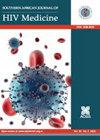向南非儿童披露人体免疫缺陷病毒状况:综合分析
IF 1.6
4区 医学
Q4 INFECTIOUS DISEASES
引用次数: 7
摘要
背景向儿童和青少年披露艾滋病毒状况的程度以及促进其披露过程的背景很少受到关注。目的评估披露情况,并对在南非半城市诊所接受抗逆转录病毒治疗的儿童(3-14岁)的披露相关特征进行全面分析。方法本研究采用结构化访谈问卷,并辅以病历资料。预测因素包括儿童、护理者、临床和社会经济特征、病毒抑制、免疫反应、依从性、健康相关的生活质量和家庭功能。结果我们纳入了190名儿童,其中45名(23.7%)接受了有关其艾滋病毒状况的披露,其中28名(14.7%)部分披露,17名(8.9%)完全披露。孩子的年龄较大和照顾者的教育程度较高与披露密切相关。女性护理人员、可检测的病毒载量、糖浆配方、司他夫定和去羟诺西碱蛋白酶抑制剂(PI)方案以及自我报告的不依从性与未披露密切相关。结论当儿童在治疗中表现良好时,照料者觉得不那么需要披露。运作良好的家庭、受过高等教育的照顾者和更好的社会经济地位促成并促进了披露。不披露可能表明存在次优社会结构,这可能对依从性和病毒抑制产生负面影响。在长期疾病管理中,迫切需要深思熟虑、积极主动地解决披露问题。为了使披露过程有益,一个有利的支持环境是重要的,这将为未来的干预提供一个巨大的机会。本文章由计算机程序翻译,如有差异,请以英文原文为准。
Disclosure of human immunodeficiency virus status to children in South Africa: A comprehensive analysis
Background The extent of disclosure of HIV status to children and adolescents and the context facilitating their disclosure process have received little attention. Objectives To assess disclosure and provide a comprehensive analysis of characteristics associated with disclosure to children (3–14 years) receiving antiretroviral treatment in a South African semi-urban clinic. Methods This cross-sectional study used structured interview administered questionnaires which were supplemented with medical record data. Predictors included child, caregiver, clinical and socio-economic characteristics, viral suppression, immune response, adherence, health-related quality of life and family functioning. Results We included 190 children of whom 45 (23.7%) received disclosure about their HIV status, of whom 28 (14.7%) were partially disclosed and 17 (8.9%) were fully disclosed. Older age of the child and higher education of the caregiver were strongly associated with disclosure. Female caregivers, detectable viral load, syrup formulation, protease inhibitor (PI) regimens with stavudine and didanosine, and self-reported non-adherence were strongly associated with non-disclosure. Conclusion When children do well on treatment, caregivers feel less stringent need to disclose. Well-functioning families, higher educated caregivers and better socio-economic status enabled and promoted disclosure. Non-disclosure can indicate a sub-optimal social structure which could negatively affect adherence and viral suppression. There is an urgent need to address disclosure thoughtfully and proactively in the long-term disease management. For the disclosure process to be beneficial, an enabling supportive context is important, which will provide a great opportunity for future interventions.
求助全文
通过发布文献求助,成功后即可免费获取论文全文。
去求助
来源期刊
CiteScore
2.80
自引率
11.80%
发文量
41
审稿时长
>12 weeks
期刊介绍:
The Southern African Journal of HIV Medicine is focused on HIV/AIDS treatment, prevention and related topics relevant to clinical and public health practice. The purpose of the journal is to disseminate original research results and to support high-level learning related to HIV Medicine. It publishes original research articles, editorials, case reports/case series, reviews of state-of-the-art clinical practice, and correspondence.

 求助内容:
求助内容: 应助结果提醒方式:
应助结果提醒方式:


